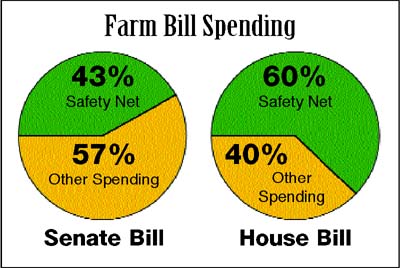Farm Bill Differences Present Major Challenge For Conference Committee

The U.S. Senate’s 58-40 passage of its version of the farm bill paved the way for creation of a conference committee, which is now trying to work out the differences between the Senate bill and one passed by the House of Representatives last fall.At stake is $73.5 billion in federal spending and policy changes that will govern how farm programs are administered for the next 10 years.The conferees task was made more difficult early this year when the Senate approved the controversial Grassley-Dorgan amendment, which could make 30 percent of farmers ineligible for federal assistance. Although Alabama Sens. Richard Shelby and Jeff Sessions voted for the Senate bill, they cited serious concerns about the legislation. Despite their reservations, both said they felt it was important to move the bill forward, so a conference report could be issued in time for spring planting. Shelby and Sessions, as well as the Bush administration, have said they favor the House version.As the conferees meet, one of the big points of contention will be how farm program spending is structured within the ten-year life of the bill. Although the Senate “frontloads” the spending in the first five years, Democrats argued that farmers need additional relief now rather than take the House bill’s more balanced approach. The Senate bill spends 61 percent of the $73.5 billion in the first five years, versus the House bill which spends 49 percent in the first five years.An analysis from the Food and Agriculture Policy Institute (FAPRI) at the University of Missouri shows how that money would be distributed between the two bills. According to FAPRI, about 57 percent of spending in the Senate bill would be for the “safety net,” which includes direct payments, decoupled payments, and marketing loans. The other 45 percent would include nutrition programs, trade, conservation, and promotion programs. In contrast, the House bill would provide 60 percent for the “safety net” while leaving 40 percent for other spending. FAPRI also pointed out that farm income would be $1.3 billion per year lower under the Senate bill.Still, the toughest hurdle for the conferees could be the the Grassley-Dorgan amendment. Alabama Farmers Federation National Affairs Director Keith Gray said the amendment would dramatically impact many of the most productive, commercially viable farmers, and could lead to the demise of most commercial-size farms in Alabama. The amendment puts such severe limitations on marketing loan gains and fixed and counter-cyclical payments, he said, production financing will be out of the question for many farmers. For example, the Senate caps payment benefits at $275,000 while the House bill raises the limit from the current $460,000 to $550,000. In addition, the amendment essentially destroys the non-recourse, marketing loan–a longstanding mainstay of farm policy that is important to producers of all loan-eligible commodities. Farmers can learn more about the two bills and the conference committee’s progress by reading Gray’s weekly Washington Update online at www.alfafarmers.org. Internet users also can track congressional legislation and email elected officials by clicking “Capital Connection” on the Alfa Farmers’ homepage.
